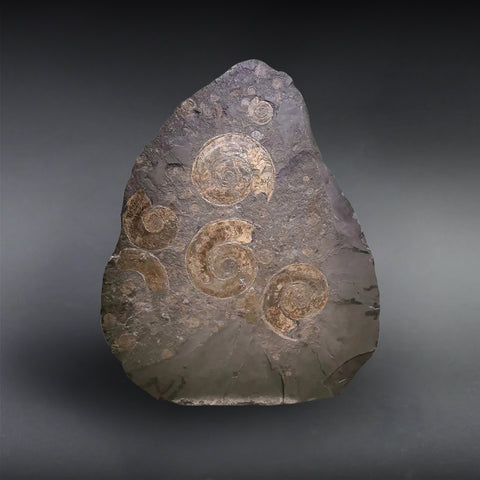Ammonite and Belemnites on Matrix
$2,600.00 USD
This superb ammonite (Parkinsonia rarecosta) and belemnites specimen was collected in Dorset, England and dates to the Jurassic period. It's a fine example of this rare ammonite affixed to natural matrix.
Ammonites have intrigued and fascinated humans for thousands of years. Many cultures - from Australian aboriginals to the ancient Egyptians - collected and treasured these prehistoric and beautiful fossils. Perhaps it has something to do with the Fibonacci spiral pattern of their shell, which mirrors the galaxies.
Ammonites belong to the mollusca phylum in a class known as cephalopods – “head-footed” creatures such as octopus and squid. They swam in ancient oceans from the Devonian Period, about 400 million years ago, to their extinction along with the dinosaurs in the Cretaceous Period, 65 million years ago.
Ammonites were free floating invertebrates that were attacked by plesiosaurs and mosasaurs, two groups of gigantic marine reptiles. One way that ammonites could avoid an attack was to quickly change their buoyancy levels, zig zagging and sinking rapidly.
These incredible prehistoric animals ranged in size from tiny species only a few centimetres in diameter to the monstrous Cretaceous ammonite, Parapuzosia seppenradensis, which grew to about 3 meters and would probably of weigh close to 1500 kilograms!
TAXONOMY
- Kingdom: Animalia
- Phylum: Mollusca
- Class: Cephalopoda
- Subclass: Ammonoidea
- Order: Ammonitida
- Family: Parkinsoniidae
- Genus: Parkinsonia
- Species: P. rarecosta
GEOLOGICAL CONTEXT
- Location: Dorset, England
- Age: Jurassic Period (201–145 million years ago)
PHYSICAL CHARACTERISTICS
- Dimensions: 8.8" tall 11.9" wide and 4.4" thick (22.5 x 30.2 x 11.1 cm)
- Measurements on display: 10.7" x 11.9" x 6.8" (27.2 cm x 30.2 cm x 17.3 cm)
- Weight: 6957 grams
Bespoke metal stand included
Please note: International buyers are responsible for any applicable import duties or taxes, which vary by country.













